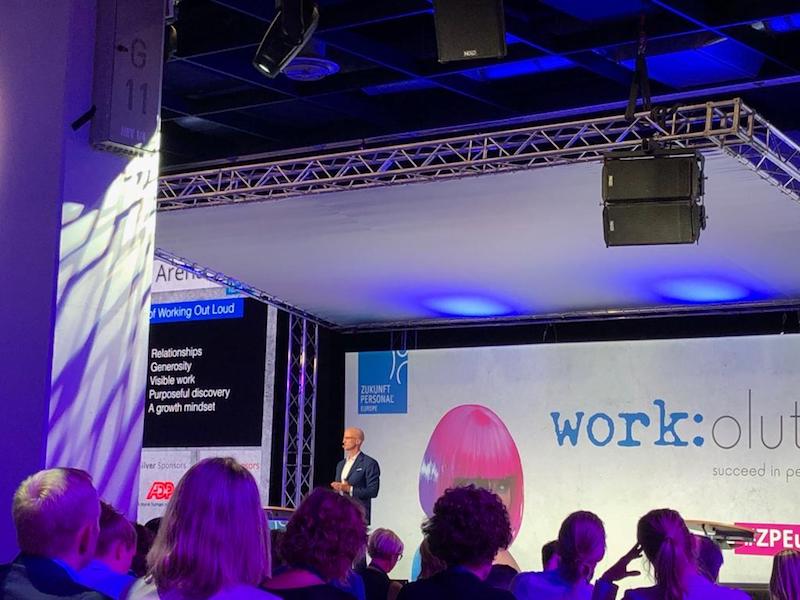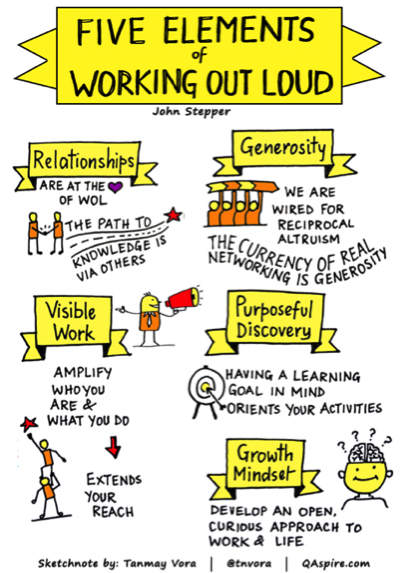25 März Experiencing ‘Working out Loud’ – A Collaboration Method
A Self-Test: My experience with Working out Loud
It all started out with working as consultant for companies like Daimler and Bayer and my interest in companies such as Bosch from people within my network. Working as coach and consultant for large corporations, I am very keen on learning the latest from these companies in respect to leadership, change, digital transformation, collaboration and personal mindset.
Last summer, I attended the HR exhibition ‘Zukunft Personal’ (Future of HR) in Cologne and met John Stepper and Sabine Kluge. John was on stage and talked about his own story.
He had spent 3 decades of his life working for big companies. One was Deutsche Bank, where I have worked as well for many years. After the event, I joined in the first circle of WOL – #WorkingOutLoud – with Sabine and started reading John’s documents about the other of 12 circles .

How to use ‘Working out Loud’ as an experienced consultant?
Every tool I use in my consultancy I usually first try for myself to make sure it works and to be convinced of its usefulness. WOL fits perfectly in my vision, that people work best in a company, where you contribute, where you share and build meaningful #networks. And it pays to my personal aim to combine agile methods with my traditional tool-kits.
So I shared my enthusiasm with two colleagues from my Coaching-Business-Network, Elke Schwarze and Viola Plump, and we started our own WOL experience from November 22 last year to February 19, 2019. It was a perfect constellation.
What is Working Out Loud?
WOL is a method to establish relationships that help people in companies explore a special topic or to make the next steps in your career. It’s networking with a personal note. For me, Working out Loud is a mindset: Show yourself and make your work visible. John Stepper defined 5 key principles to make this a success:

- Relationships: Relationships are the heart of Working out Loud. People have an intrinsic need to feel connected to something or someone and WOL is tapping into this. As you deepen your relationships with people they are more likely to help or collaborate with you.
- Generosity: Generosity is about sharing knowledge without expecting anything in return. This could be done by making your work visible or simply giving attention or showing appreciation to your colleagues.
- Visible work:When making your work visible, people learn who you are and what you do. The feedback you receive can make you and your work only better – through Social Media or simply a coffee or lunch date.
- Purposeful discovery: WOL is always connected to a goal because you want to make your contribution effective. The goals can be very simple like “I’d like to learn more about finance” or “I’d like to explore other departments I could work for”.
- Growth mindset: We are all not perfect but have our setbacks, disappointments and failures. Seeing challenges as opportunities for growth will help you to try out new things and create a passion for learning.
How can YOU learn WOL?
Working out loud is pretty simple and you can just try it out. Maybe you want to get better at a specific topic or you want to seek new opportunities at work. Creating or joining a WOL circle will help you achieve your goal. I found my circle by myself – just by asking and inspiring my colleagues.
You could start your own circle using your social #networks. Circles are most effective with 4-5 people of different backgrounds. Your circle meets for an hour a week for 12 weeks – all in a safe space without judgment. A short and simple guide which you find online helps you to structure each meeting. When it comes to running the actual meetings, circles work best when you have two simple but important roles: a #facilitator and a #timekeeper.
What makes this method so special is that it requires very little time to function. That’s something I find truly unique. The three of us only met once a week via online conference for one hour, did not make any thorough preparations for the next appointment and so much has come out of it despite our tight schedules. I found it easy to integrate well into everyday life without any stress. It really gives you the courage to try it out.
WOL – For whom is it relevant? What did WE experience?
It is very useful tool to bring people across different teams or departments together. By setting up WOL circles you can create a hybrid structure combining the benefits of hierarchy and working in networks which is key in a digital world. It offers the possibility to connect people independently from their hierarchy or culture.
It is a simple and effective way to reach a goal you have set for yourself by investing a small amount of time in collaborating with people you have not known before. It is a method that can help people feel more connected, empowered and happier at work.
In my personal experience, I know the 2 other colleagues very well, because we have been working together for several years at Deutsche Bank and in our Coaching-Business-Circle as consultants. Nevertheless, we learned a lot about each other and it actually improved the transparence in our collaboration. I achieved my aim to combine agile methods with my traditional tool-kit and gained a lot of thought food for my self-marketing.
And although we all are experienced coaches that work together confidentially, we loved to go through this intensive and broad process.
When you test it for yourself, I highly recommend however to choose a circle with people from different disciplines.
I am looking forward to my next WOL circle or exchanging experiences with you.
Source: John Stepper „Working Out Loud: For a better career and life“ https://workingoutloud.com/
Connect with me via XING and LinkedIn.
#wol #workingoutloud #facilitator #timekeeper #networks



